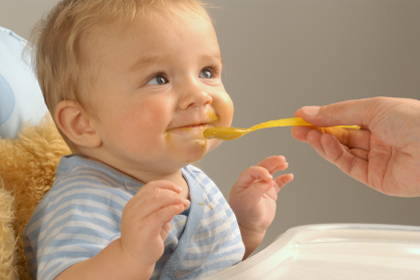 When it comes to putting things in their mouths, infants and toddlers don’t discriminate between food and non-food. A shiny coin, a small toy — even a dab of dirt can seem like a perfectly acceptable delicacy.
When it comes to putting things in their mouths, infants and toddlers don’t discriminate between food and non-food. A shiny coin, a small toy — even a dab of dirt can seem like a perfectly acceptable delicacy.
While mouthing is a normal part of your baby’s development and provides important sensory information, it’s important to watch what they put in their mouth in order to reduce their risk of choking. According to the Centers for Disease Control and Prevention (CDC), more than 17,000 infants and children are treated each year in hospital emergency rooms for choking-related incidents, and more than 80 percent of those occur in children ages 4 and younger.
You can encourage your baby’s sensory development by providing them with objects they can safely mouth, such as teething toys that are sturdy and have smooth edges with no balls or beads that can be swallowed. You will also need to be vigilant about your baby’s access to little objects. “A good rule of thumb for parents is if an object is small enough to fit into a toilet-paper tube, then it’s too small for your little one,” says Karen Kim, public affairs officer for the American Red Cross in Tacoma.
The list of little things the American Academy of Pediatrics says you should keep well away from your tot includes latex balloons and balloon pieces, coins, marbles, toys with small parts, small balls, pen or marker caps, batteries and medicine syringes. Experts say parents need to have an eagle eye — even when they think there are no choking hazards around.
“Supervision is the best prevention,” says Jackie Kittelson, health and safety instructor for the American Red Cross. “Keep your infant or toddler close so that you can monitor what they put in their mouth.”
Babysitters that you can trust
When leaving your child in the care of a babysitter, friend or family member, make sure that your caregiver’s home is childproofed and that they are aware of age-appropriate foods. “Talk with your baby-sitter about what you expect them to feed your child, and prepare meal plans in advance,” says Dr. Julie Brown, an assistant professor at the University of Washington and an attending physician in the Seattle Children’s Hospital Emergency Department. “Warn your baby-sitter to be particularly vigilant if you have older children who might offer your young child inappropriate food or toys.”
Brown advises hiring babysitters who have completed a baby-sitting class. Seattle Children’s Hospital, offers two baby-sitting classes: Better Baby Sitters and CPR for Babysitters. There is also an online baby-sitting class offered at babysittingclass.com. Parents, grandparents and prospective baby-sitters can also take infant and child CPR courses through the American Red Cross.
Safe foods for your baby
Almost all solid foods carry some risk of choking, and since young children have poor chewing ability and narrow airways compared to older children and adults, parents and caregivers need to be aware of what their little ones are consuming.
“Parents should cut solid foods into thin slices before feeding them to young children,” Brown says. The American Academy of Pediatrics recommends that children younger than 4 avoid these foods: hot dogs; nuts and seeds; chunks of meat and cheese; whole grapes; hard, gooey or sticky candy; popcorn; chunks of peanut butter; raw vegetables; raisins; and chewing gum.
Children should also be sitting, not lying down or in motion, when eating, to reduce their risk of choking. Being prepared in case of an emergency makes sense, so parents should know basic choking rescue procedures.
“We encourage all parents to have an emergency plan and to know the steps to take in the event that their child begins to choke,” says Kim. “Taking a CPR class gives parents confidence and allows them to stay calm and not panic in an emergency.”
How to relieve a choking infant (under age 1)
After calling 911:
1. Hold the infant face down on your forearm. Support the infant’s head and jaw with your hand. You may need to sit or kneel and rest your arm on your lap or thigh.
2. Give up to five blows to the back with the heel of your free hand. If the object comes out and the infant begins to breathe after only a few back blows, stop the back blows.
3. If the object does not come out after five back blows, turn the infant onto his or her back and give as many as five chest thrusts, supporting the head and neck. Hold the infant with one hand and arm. Use two or three fingers of your free hand to push on the breastbone just as you press for chest compressions during CPR. Stop chest thrusts if the object is forced out.
4. Alternate giving five back blows and five chest thrusts until the object comes out or the infant becomes unresponsive.
If the choking is not relieved, the infant will become unresponsive. When the infant becomes unresponsive, shout for help and start CPR. Chest compressions may force the object out. If you are alone with the infant and these steps don’t work after about one minute, phone 911 if you haven’t already done so.
How to relieve a choking child (over age 1)
1. Ask, “Are you choking?” If the child speaks or is coughing, do nothing. Allow the child to try to cough up whatever is blocking the windpipe. If the child can’t speak, cough loudly or cry, tell the child you are going to help.
2. Stand or kneel firmly behind the child and wrap your arms around the child. Make a fist with one hand. Put the thumb side of the fist on the child’s abdomen, slightly above the navel and well below the breastbone.
3. Grasp the fist with your other hand and give quick upward thrusts into the child’s abdomen.
4. Give thrusts until the object is forced out or the child becomes unresponsive. If the choking is not relieved, the child will become unresponsive. When the child becomes unresponsive, shout for help, lower the child to the ground, and start CPR. Chest compressions may force the object out. If you are alone with the child and these steps don’t work after about one minute, phone 911 if you haven’t already done so.
Heather Larson is a freelance writer who frequently writes about health and parenting topics for a variety of magazines.
Sources: The American Red Cross and The American Heart Association











